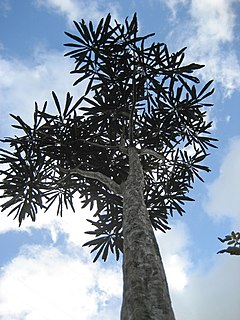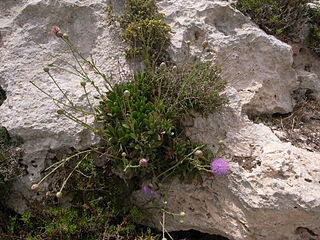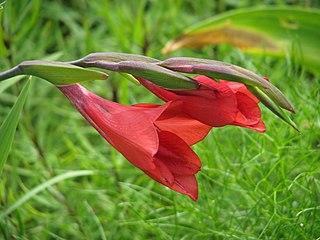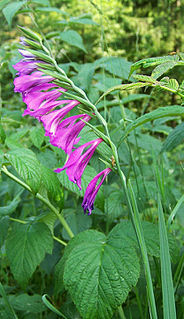
A corm, bulbo-tuber, or bulbotuber is a short, vertical, swollen underground plant stem that serves as a storage organ that some plants use to survive winter or other adverse conditions such as summer drought and heat (perennation).

Iridaceae is a family of plants in order Asparagales, taking its name from the irises, meaning rainbow, referring to its many colours. There are 66 accepted genera with a total of c. 2244 species worldwide. It includes a number of other well known cultivated plants, such as freesias, gladioli and crocuses.

Gladiolus is a genus of perennial cormous flowering plants in the iris family (Iridaceae).

Pseudopanax crassifolius, the horoeka or lancewood, is a New Zealand native tree belonging to the family Araliaceae. It is found throughout New Zealand from sea level up to about 750 m. The juvenile form, which lasts for between 15 and 20 years, is very easily recognized. The leaves are stiff and leathery with a prominent central rib, about 1 cm wide and up to 1 m long with irregular teeth, all growing downwards from a central stem. The young trunk has characteristic vertical swollen ridges. As the tree gets older the stem begins to branch, producing a bushy top, and the leaves become wider and shorter, losing their teeth. It is only when the tree is mature that it adopts a typical tree shape.

Gladiolus murielae is a species of flowering plant in the family Iridaceae, native to eastern Africa, from Ethiopia to Malawi. It has been given a number of English names, including Abyssinian gladiolus and fragrant gladiolus. It was formerly placed in the genus Acidanthera.

Cheirolophus crassifolius, the Maltese centaury, Maltese rock-centaury or Widnet il-Baħar, is a species of flowering plant in the family Asteraceae. It is endemic to Malta, where it has been the national plant of Malta since 1973. Its natural habitats are cliffs and coastal valleys. It is threatened by habitat loss.
Hosackia crassifolia, synonym Lotus crassifolius, is a species of legume native to Washington, California and Oregon. It is known by the common names big deervetch and broad-leafed lotus.

Ceanothus crassifolius is a species of flowering shrub known by the common name hoaryleaf ceanothus. This Ceanothus is found throughout the coastal mountain ranges of the southern half of California, and its range extends into Baja California.

Gladiolus italicus is a species of gladiolus known by the common names Italian gladiolus, field gladiolus, and common sword-lily.

Crocoideae is one of the major subfamilies in the family Iridaceae.

A stem is one of two main structural axes of a vascular plant, the other being the root. It supports leaves, flowers and fruits, transports water and dissolved substances between the roots and the shoots in the xylem and phloem, stores nutrients, and produces new living tissue.

Cut flowers are flowers or flower buds that have been cut from the plant bearing it. It is usually removed from the plant for decorative use. Typical uses are in vase displays, wreaths and garlands. Many gardeners harvest their own cut flowers from domestic gardens, but there is a significant floral industry for cut flowers in most countries. The plants cropped vary by climate, culture and the level of wealth locally. Often the plants are raised specifically for the purpose, in field or glasshouse growing conditions. Cut flowers can also be harvested from the wild.

Gladiolus palustris, common name marsh gladiolus or sword lily, is a herbaceous perennial plant belonging to the genus Gladiolus of the family Iridaceae. The genus name Gladiolus is the Latin diminutive of gladius, a sword, while the specific Latin name palustris, meaning growing in marshes, refers to the alleged environment of this species.
Gladiolus dichrous is a species of flowering plant found in mountainous regions of South Sudan, Kenya and Uganda. It has relatively small flowers usually hidden under large green or rose coloured bracts.

Gladiolus flanaganii is a Gladiolus species found in cliffs of the Drakensberg in Natal, South Africa.

Gladiolus watsonioides is a medium to high (½–1 m), herbaceous geophyte with sword-shaped leaves, flattened in the plain of the stem, and spikes of red funnel-shaped flowers, that is assigned to the iris family. In the wild, the species is restricted to the highlands of central Kenya and northern Tanzania, including on Kilimanjaro, Mount Kenya and the Aberdare Range. It is sometimes called Mackinder's gladiolus.

Euryops brownei is a woody herb or shrub of ½–3 m (1⅔–10 ft) high, with yellow flowerheads of both ray and disc florets, and small, narrow leaves, belonging to the daisy family. The species is native to the highlands of northern Tanzania and central Kenya.
Chionanthus crassifolius is a species of flowering plants in the family Oleaceae. It is found in Brazil.
Gladiolus mariae is a species of the genus Gladiolus of perennial cormous flowering plants in the family Iridaceae.

Gladiolus imbricatus is a Gladiolus species.















